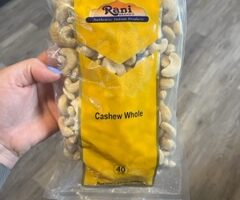
293, East St, Maligampattu, Maligam Pattu, Tamil Nadu 607106, India
How is it produced?
Indian farmers tend to crops of tropical evergreen trees called Cashew Trees that produce the cashew apple and nut. Next, the product needs to be sun-dried, roasted shelled and peeled, which takes place in adjacent factories, this work is done primarily by rural women.
Moreover, the laborious effort to get the cashews to an edible state often includes steaming the nut, which in turn releases caustic acid that can burn skin, mouth and tongue.
Describe the supply chain to the store shelf in Canada:
Canada and India have a bilateral trade agreement which is called the Comprehensive Economic Partnership Agreement (CEPA).
What is the power balance between the producer and seller?
This dichotomy is complicated and often consists of ethical problems that are not faced in global north countries.
Several different types of subsidies were provided for farmers, however for cashew farmers, banks and state governments offered conditional subsidies which most notably favoured one type of cashew- the cultivar variety as opposed to the traditional cashew tree. The cultivar varieties offer higher yields and mature quicker than the traditional tree. However, the cultivar varieties are less resilient to pests and require pesticides and fertilization whereas the traditional tree does not possess such vulnerabilities. The desired monetary gains of a higher yielding and shorter maturation rate were not always the outcome for the farmers.
The labour of rural women is critical, so much so that women make up approximately 93 percent of workers in the industry (Binu & Abdul, pp. 88).
However, it should be noted large-scale factories do exist and offer suitable wages and better working conditions. However, these are often state-owned enterprises where employment opportunities do not extend to the most necessitous. In turn, due to the end product being a shelled cashew, it is impossible to differentiate from where the finished product comes from. Researchers published in the Global Labour Journal found a system that curtails the ethics perceived with the larger scale factories. In many instances, an agent allows cashews to be distributed to unregistered operations such as the homes of women to be shelled and returned for payment and later returned to the factories for distribution both domestically and internationally (Kuzhiparambil, pp.286-287).
Can you recommend changes to the system to improve the balance?
Risk mitigation via proper equipment is the most suggested solution but the implementation is difficult due to many cashew operations being private and small-scale.
Therefore greater supply chain transparency is one potential suggested solution to ensuring consumers can make informed decisions.
A diverse mixture of cashew trees, both traditional and cultivar varieties would be best suited.
References/Resources:
Borah, S., Chetia, D., Marak, T. R., Chauhan, N. S., & Kumar, A. (2019). Musculoskeletal disorder faced by women workers in cashew nut processing industries of North-East India. Anthropologist, 38(1-3), 1-8.
Canada, G. A. (2023). Government of Canada. GAC. https://www.international.gc.ca/trade-commerce/trade-agreements-accords-commerciaux/agr-acc/india-inde/cepa-apeg/index.aspx?lang=eng
Kuzhiparambil, A. (2016). A secondary informal circuit of globalisation of production: Home-based cashew workers in Kerala, India. Global Labour Journal, 7(3). https://doi.org/10.15173/glj.v7i3.2704
Madhura, K., Raghavendra, B., & Ramakrishna, B. (2020). An Empirical Study on Issues and Challenges in Working Conditions of Feminine Labours Engaged in Cashew Industries. Shanlax International Journal of Economics.
Rege, A., & Lee, J. S. H. (2022). State-led agricultural subsidies drive monoculture cultivar cashew expansion in northern Western Ghats, India. PLoS ONE, 17(6), 1–19. https://doi.org/10.1371/journal.pone.0269092

